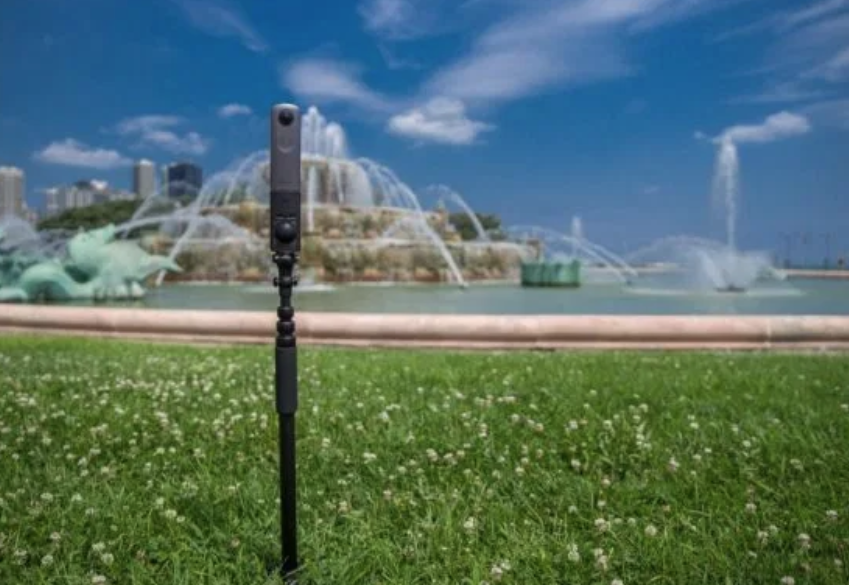360 degree cameras aren’t VR — and it’s important we say so

The Ricoh Theta V does 360° images…which isn’t VR.
Image Credit: Ricoh
The consumer electronics industry is evolving every day, and the world of cameras is no exception. We’re seeing incredible things happen with photography, and recent products like the GoPro Fusion and Ricoh Theta V are pushing the industry forward. But despite all of their advancements, there’s one thing many recent cameras are claiming to accomplish that they simply don’t: virtual reality.
As manufacturers, we are part of the group who will set the trend for how each technology is perceived by the public. It is our responsibility to help define the lexicon. But even this deep in the camera industry, there seems to be confusion at the highest levels about what virtual reality is and how it differs from other 360 degree camera technology. As a result, this confusion is being passed on to the consumer, leading many to think that the terms “virtual reality” and “360 degrees” are synonymous. They aren’t.
What’s the difference?
360 degree cameras, while they can produce photos and videos that can be viewed in a virtual reality headset, output traditional 2D images. In a word, they’re flat. These cameras excel at creating fully surround images that users can explore on devices such as smartphones, tablets — or in the case of the Ricoh Theta V, even your living room TV. But at the end of the day, this still isn’t virtual reality.
VR cameras differentiate themselves by creating a sense of depth, recording their footage in full 3D. This creates a wildly different sense of immersion, using sight and sound to trick the brain into feeling like it’s been transported to another world. Unlike 360 degree cameras, which limit you to looking at captured footage, VR lets you step into that footage. It’s a totally different experience.
Despite this distinct difference between 360 degree cameras and virtual reality cameras, when it comes to marketing new products, many companies are taking the former and claiming them to be the latter. We are seeing 360 degree cameras that produce flat 2D images with the label “VR” right on the box. Whether a clever deception or a genuine misunderstanding, this mis-labelling of products only fosters consumer confusion about a growing space of the market. While the end user may not understand the difference between 360 and VR, manufacturers should — and it’s our responsibility to educate the consumer properly by coming together to create standards by which each term applies.
Why that matters
Admittedly, this would be an easier distinction to make if the technologies weren’t so similar on paper — but it is this very similarity that demands we do a better job of explaining the differences to consumers. Perhaps the terms “virtual reality” and “360 degree” camera are at the root of the problem. After all, both conjure up a similar image in the minds of end users. Both 360 and VR camera technologies capture footage in 360 degrees. Both let users look around the environment by turning their head in 360 degree space. How can we help consumers understand that, despite these similarities in their product descriptions, the realities of each are as different as night and day?
If the solution is that we need new terminology for these cameras — and I’m not sure that it is — than we need to start a conversation about what those terms might be. In the end, we need to be using words that can eliminate the confusion gap entirely for manufacturers and consumers alike. And if we don’t need new words, than we need consistent application of the existing terms for these products across the industry. Consistency is the key to clarity.
No matter what form the solution takes, we need to find it soon. Virtual reality is on the precipice of mass consumer adoption, and leaving consumers unclear of what sets it apart of 360 degree videos is only going to harm the industry at large.
Looking at the accomplishments of our peers, it would be foolish of me to discount the amazing steps forward that cameras like the Theta V and GoPro Fusion represent. Allowing you to wirelessly transmit 360 videos to your television puts the Theta V in a class of its own, and the GoPro Fusion is poised to reinvent video editing with their Over Capture technology, which essentially turns videography into a post-capture task.
But despite all of their progress, claims that these cameras can produce outputs in VR, without 3D capabilities, are simply unfounded. If we genuinely disagree on what VR is, then it’s time to settle that debate. There is a pretty clear distinction between 360 degree capture and VR, both in created output and intended end user engagement. If we intend to foster understanding and adoption of VR technology, it is our responsibility as an industry to educate the consumer on the difference.

Jim Malcolm brings more than two decades of imaging, virtual reality (VR) and consumer products experience to his role as General Manager, North America, at Humaneyes.

